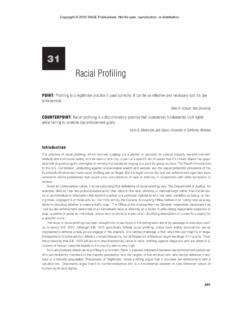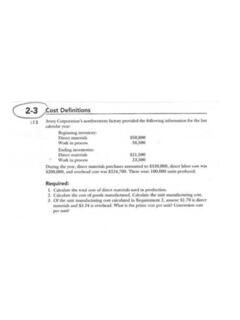Transcription of Econ 230A: Public Economics Lecture: Public Goods ...
1 Econ 230A: Public EconomicsLecture: Public Goods , ExternalitiesHilary HoynesUC Davis, Winter 2010 Hilary Hoynes ()PG-ExternalitiesUC Davis, Winter 20101 / 77 OutlinePublic Goods1 What are Public Goods ?2 First Best: The Samuelson Rule3 Decentralized Implementation4 Crowd-Out5 Empirical Evidence on Crowd-OutExternalities1 What are externalities?2 Correcting Externalities3 Prices. vs. Quantities4 Optimal 2nd Best Taxation with Externalities5 Empirical ApplicationsHilary Hoynes ()PG-ExternalitiesUC Davis, Winter 20102 / 771. What are Public Goods ?Thus far, we have discussed how to set up a tax system to optimallycollect money and meet a revenue questions: Why do we want to raise that money?1fund Public Goods (correct externalities)2 x market failures (social insurance)3redistributionStart now with the Public nance of Public Hoynes ()PG-ExternalitiesUC Davis, Winter 20103 / 771.
2 Public Goods - what we will doHow do we characterize Goods that ought to be provided publically(Note we are concerned with publicprovisionnot publicproduction)If the government knew the preferences of all members of society,how ought the supply of Public Goods be determined?What pricing should be used?Does one need to worry about moral hazard?Crowdoutof privateprovision?Hilary Hoynes ()PG-ExternalitiesUC Davis, Winter 20104 / 771. What are Public Goods ?Nonrivalry: rst feature of Public goodsPrivate Goods only bene t a single user (eg coke) Public Goods provide bene ts to a number of users simultaneously (egteaching a class)IIf Public good can accommodate any number of users: it this case, given the existence of the Public good at the given scalethen the marginal cost of adding another user = congestion occurs, it isimpure.
3 (roads with tra c). [MC of addinganother user>0]More generally: a pure Public good is characterized of the Public good by one household does not reduce thequantity available for consumption for the others. Ex: National Hoynes ()PG-ExternalitiesUC Davis, Winter 20105 / 771. What are Public Goods ?Excludability:second feature of Public goodsIs it possible to exclude individuals from consuming the Public good ?IExample: National Radio: impossible to exclude. Teaching: possibleto , or extremely costly to exclude from consuming the publicgood (critical for free rider problem)IThis is often related to technologyMost economic analysis focuses on pure Public goodsIAbstraction (no Public good is really pure) but useful Hoynes ()PG-ExternalitiesUC Davis, Winter 20106 / 771.
4 Public Goods and Implications for demandLethdenote households in the economyFor private Goods , we have hXh=X, aggregate demand is thesum of individual demandsFor Public Goods , we have thatXh=Xfor everyhIIf there is free disposal (not everyone has to consume the good ) thenXh Xfor everyhHilary Hoynes ()PG-ExternalitiesUC Davis, Winter 20107 / 772. First Best Allocation: The Samuelson RulePublic good does not t into usual competitive framework ofArrow-Debreu b/c of production externalitiesI)competitive outcome may not be e withHhouseholds, indexed byh=1,..,HTwo always private, individual byX= hXhtotal quantity of goodXconsumed in Hoynes ()PG-ExternalitiesUC Davis, Winter 20108 / 772. First Best: The Samuelson RuleSuppose rst thatGis privateDenote byGhconsumption of goodGbyh, withG= ofhisUh=Uh(Xh,Gh).
5 Assume thatUhis increasing welfare = weighted sum of utilities, hweight onhin socialwelfareI h 0 and at least one h> possibilityF(X,G)= Hoynes ()PG-ExternalitiesUC Davis, Winter 20109 / 772. First Best: The Samuelson Rule (G private)To identify Pareto e cient outcomes (highest SWF givenconstraints), solve:max h hUh(Xh,Gh) ( hXh, hGh) 0 FOCs using on the constraints:[Xh]: hUhX= FX[Gh]: hUhG= FGHilary Hoynes ()PG-ExternalitiesUC Davis, Winter 201010 / 772. First Best: The Samuelson Rule (G private)Taking ratios of FOCsUhGUhX=FGFXMRShGX=MRTGX8hThis de nes the pareto e cient allocationsCondition says: Marginal rates of substitution betweenGandXequal across individuals and equal to the marginal rate oftransformation private Goods we know we can get there because we all choose Xst MRS=price.
6 By our ability to choose X (and our being forced topay for X to consume X), prices work!IFirst Welfare Theorem!!Hilary Hoynes ()PG-ExternalitiesUC Davis, Winter 201011 / 772. First Best: The Samuelson RuleNow supposeGis a pure Public level of PG, which everyone ofhisUh=Uh(Xh,G). (Gh=G8h)Production possibilityF(X,G)=0 as , solve same optimzation (max SWF st PPF)Hilary Hoynes ()PG-ExternalitiesUC Davis, Winter 201012 / 772. First Best: The Samuelson RuleTo identify Pareto e cient outcomes,max h hUh(Xh,G) ( hXh,G) 0 FOC s:[Xh]: hUhX= FX[G]: h hUhG= FGUsing h= FX/UhXfromXh-FOC combine withG-FOC to obtain: hUhGUhX=FGFXH ilary Hoynes ()PG-ExternalitiesUC Davis, Winter 201013 / 772. First Best: The Samuelson Rule hMRShGX=MRTGXC ontrast with private good case: Condition for Pareto e ciency:sum ofMRS is equal to is the Samuelson Rule (developed in famous ReStat 1954, 3page paper by Samuelson).
7 Intuition: The MB of an increase in G of one unit is the sum of theMB for each person (which in the optimum is = MC). This is incontrast to the private good case where the indi MB equals the Hoynes ()PG-ExternalitiesUC Davis, Winter 201014 / 772. First Best: The Samuelson RuleRemarks:This solution works in a "fully controlled" situation where thegovernment has perfect information about preferences and then canset G formula above does not account for any distortionary taxes thatare needed to raise funds for the Public plays no role in the analysis. Excludability is onlyrelevant for determining feasible provision this sense,Samuelson analysis can be considered as a First-Best question: How can optimal provision of Public good bedecentralized given available policy tools and respecting informationconstraints?
8 Hilary Hoynes ()PG-ExternalitiesUC Davis, Winter 201015 / 77 What if we can get rst best?1 Subscription Equilibrium: What happens if there is no governmentinvolvement in the Public good ?.2 Lindahl Equilibrium: Is there a mechanism that gets us to paretoe cient solution (with similarities to competitive market equilibrium)?3 Voting Equilibrium: What happens with political models of voting?[we will spend less time on this]Generally, how can optimal provision of Public good be decentralizedgiven available policy tools and respecting information constraints?Hilary Hoynes ()PG-ExternalitiesUC Davis, Winter 201016 / 77 Public good with no governmentPure Public good in the model we have outlined (nonrival,nonexcludable)Free rider problem.
9 No group would voluntarily pay for the publicgood. They can get access to the Public good even if they do is called the Nash equilibrium Pareto-e cient. market outcome leads to underprovision of publicgoodYet, we see people contributing to charitiesIEarthwquake in HaitiIIncrease in contributions to food pantries in the current recessionPeople may derive direct utility from giving:U(Xh,Gh,G).IThis is Andreoni s (1990 Economic Journal) famous warm glow model of charitable contributions that is now viewed as the centralparadigm in this will come back to this shortly (crowdout- what happens to privatecontributions when government funding increases?)Hilary Hoynes ()PG-ExternalitiesUC Davis, Winter 201017 / 773. Decentralized Implementation - Lindahl PricesHow can the e cient outcome be implemented?
10 Idea: can we come up with "individualized prices" that vary acrossindividuals re ecting their willingness to payKnown as Lindahl share (of total cost of Public good ) becomes individualized priceEquilibrium is a set of prices such that all persons demand the samelevel of the Public Hoynes ()PG-ExternalitiesUC Davis, Winter 201018 / 773. Decentralized Implementation - Lindahl PricesModel:private goodXand a pure Public household starts with an endowmentYhof that individualhhas to pay a share hof the Public goodand, given that, can choose freely their desired level of the publicgoodG. Individualhcontributes hGto Public good funding (paysthis amount)IndividualhmaximizesUh(Xh,G)stXh+ hG= FOC forXhandG, and then the ratios of FOC: hUhX=UhGDemand function ofGh=Gh( h,Yh)Hilary Hoynes ()PG-ExternalitiesUC Davis, Winter 201019 / 773.












